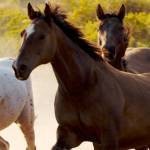Ancestry of Przewalski’s Horse Studied

Recent research has suggested that modern domestic horses and wild Przewalski’s horses are distant cousins, having diverged from a common ancestor at least 38,000 years ago. Though they are somewhat similar in appearance, the two species have unique genomes with a different number of chromosomes. Previously, geneticists had been uncertain as to whether Przewalski’s horses originated from domestic strains or were truly wild horses constituting a separate species of equines.
Using bone fragments from a 700,000-year-old extinct horse species found in Canada, Danish researchers mapped the genome of this equine and compared it to genomes of a modern donkey, five modern domestic samples, a pre-domestication horse from about 43,000 years ago, and a modern Przewalski’s horse. The study indicated that all the equines except the Przewalksi’s horse originated between 4 and 4.5 million years ago. Przewalski’s horses and domestic horses diverged 38,000 to 72,000 years ago. Evidence indicates there has been no cross-breeding between the two types of equines.
Przewalski’s horses have some obvious physical differences when compared to modern horses. In addition to an extra pair of chromosomes, the wild horses show wide genetic diversity, a fact that is important for the future of the species which will come from a limited number of individuals.
The study showed many demographic fluctuations in horse populations during the last two million years, especially during periods of major climatic changes. Evidence was also found to support the continuous selection of the immune system and the sense of smell throughout horse evolution.
Przewalski’s horses were first described in the 1800s in their native habitat of Mongolia. Their numbers dwindled until the species was considered extinct in the wild. A captive breeding program using animals from zoos was successful in rebuilding the population, and a herd was reintroduced to Mongolia in the 1990s.








